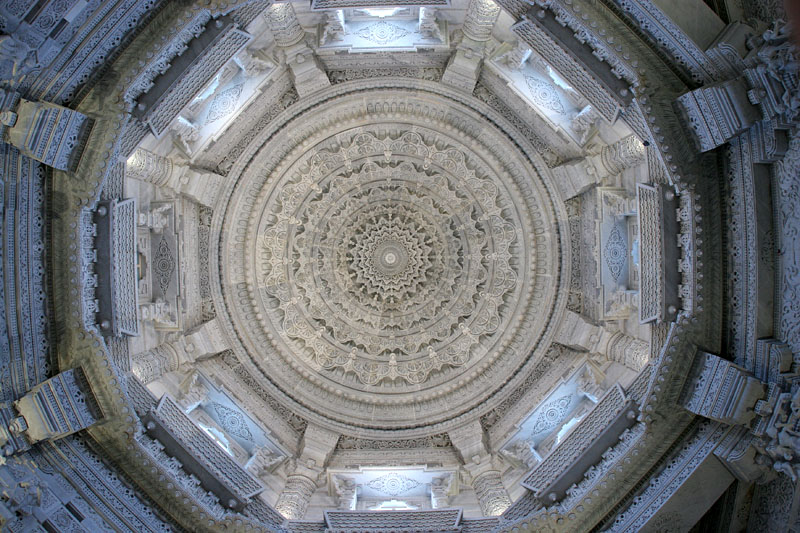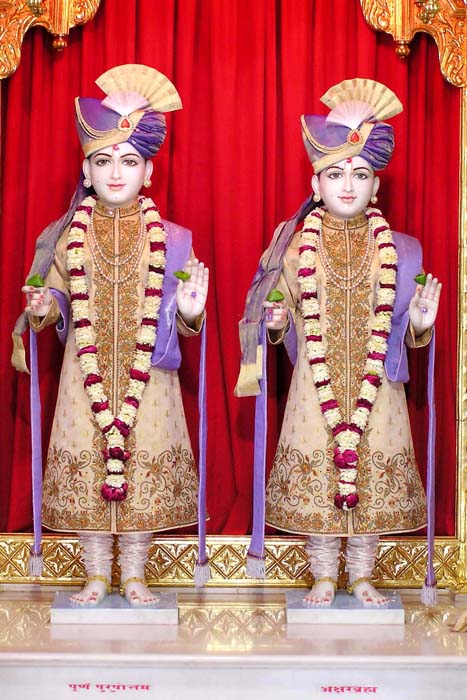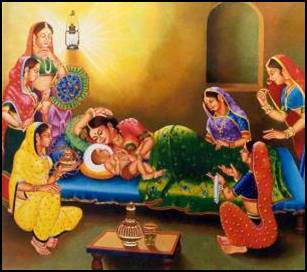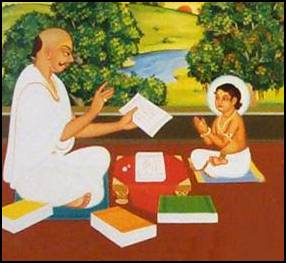|
BAPS
Bochasanwasi Akshar Purushottam Swaminarayan Sanstha (BAPS; ) is a Hindu denomination within the Swaminarayan Sampradaya. It was formed in 1905 by Yagnapurushdas (Shastriji Maharaj) following his conviction that Swaminarayan remained present on earth through a lineage of gurus starting with Gunatitanand Swami. Since 1971, under the leadership of Pramukh Swami Maharaj, the BAPS has grown strongly. As of 2019, BAPS has 44 shikharbaddha mandirs and more than 1,200 Hindu temple, mandirs worldwide that facilitate practice of this doctrine by allowing followers to offer devotion to the murtis of Swaminarayan, Gunatitanand Swami, and their successors. BAPS mandirs also feature activities to foster culture and youth development. Many devotees view the mandir as a place for transmission of Hindu values and their incorporation into daily routines, family life, and careers. BAPS also engages in a host of humanitarian and charitable endeavors through BAPS Charities, a separate non-profit ... [...More Info...] [...Related Items...] OR: [Wikipedia] [Google] [Baidu] |
BAPS Charities
BAPS Charities (formerly BAPS Care International) is an international, non-religious, charitable organization that originated from the Bochasanwasi Akshar Purushottam Swaminarayan Sanstha (BAPS) with a focus on serving society. This focus on service to society is stated in the organization's vision, that "every individual deserves the right to a peaceful, dignified, and healthy way of life. And by improving the quality of life of the individual, we are bettering families, communities, our world, and our future." BAPS Charities carries out this vision through a range of programs addressing health, education, the environment, and natural disaster recovery. The organization's worldwide activities are funded through donations and are led by a community of over 55,000 volunteers who are mostly members of BAPS. The volunteers work with local communities and other charities and the organization's activities are mainly based out of their mandirs. History The Bochasanwasi Akshar Purusho ... [...More Info...] [...Related Items...] OR: [Wikipedia] [Google] [Baidu] |
Swaminarayan Sampradaya
The Swaminarayan Sampradaya, also known as Swaminarayan Hinduism and Swaminarayan movement, is a Hindu Vaishnava sampradaya rooted in Ramanuja's Vishishtadvaita, characterized by the worship of its charismatic founder Sahajanand Swami, better known as Swaminarayan (1781–1830), as an avatar of Krishna or as the highest manifestation of Purushottam, the supreme God. According to the tradition's lore, both the religious group and Sahajanand Swami became known as ''Swaminarayan'' after the Swaminarayan mantra, which is a compound of two Sanskrit words, swami ("master, lord") and Narayan (supreme God, Vishnu). During his lifetime, Swaminarayan institutionalized his charisma and beliefs in various ways. He constructed six mandirs to facilitate followers' devotional worship of God, and encouraged the creation of a scriptural tradition''.'' In 1826, in a legal document titled the Lekh, Swaminarayan created two dioceses, the Laxmi Narayan Dev Gadi (Vadtal Gadi) and Nar Nara ... [...More Info...] [...Related Items...] OR: [Wikipedia] [Google] [Baidu] |
Gunatitanand Swami
Gunatitanand Swami (28 September 1784 – 11 October 1867), born Mulji Jani, was a prominent paramhansa of the Swaminarayan Sampradaya who was ordained by Swaminarayan and is accepted as the first spiritual successor of Swaminarayan by the Bochasanwasi Akshar Purushottam Swaminarayan Sanstha (BAPS). Born into a religious family in the small farming community of Bhadra in Gujarat, India, he first received religious education under his father's guru, Ramanand Swami before encountering Swaminarayan and becoming a swami under him at the age of 25. He was revered for his spiritual discourses and divine service For the BAPS, he embodies an essential element of the doctrine of Akshar and Purushottam. They believe based on interpretation from the Vachanamrut that "Akshar is an eternally-existing spiritual reality having two forms, the impersonal and the personal". Furthermore, BAPS claims that Gunatitanand Swami was believed to be the first personal manifestation of Akshar in the Gu ... [...More Info...] [...Related Items...] OR: [Wikipedia] [Google] [Baidu] |
Swaminarayan Akshardham (New Delhi)
Swaminarayan Akshardham is a Hindu temple, and spiritual-cultural campus in Delhi, India. The temple is close to the border with Noida. Also referred to as Akshardham Temple or Akshardham Delhi, the complex displays millennia of traditional and modern Hindu culture, spirituality, and architecture. Inspired by Yogiji Maharaj and created by Pramukh Swami Maharaj, it was constructed by BAPS. The temple was officially opened on 6 November 2005 by Pramukh Swami Maharaj in the presence of Dr. A. P. J. Abdul Kalam, Manmohan Singh, L.K Advani and B.L Joshi. The temple, at the centre of the complex, was built according to the ''Vastu shastra'' and '' Pancharatra shastra''. In Swaminarayan Akshardham, similar to its predecessor Swaminarayan Akshardham in Gandhinagar, Gujarat, the main shrine is the focal point and maintains the central position of the entire complex. There are various exhibition halls which provide information about the life and work of Swaminarayan. The designers of ... [...More Info...] [...Related Items...] OR: [Wikipedia] [Google] [Baidu] |
Shastriji Maharaj
Shastriji Maharaj (31 January 1865 – 10 May 1951), born Dungar Patel and ordained Shastri Yagnapurushdas, was a swami of the Swaminarayan Sampradaya and founder of the Bochasanwasi Akshar Purushottam Swaminarayan Sanstha (BAPS). Several branches accept him as the third spiritual successor of Swaminarayan in the lineage of Aksharbrahma Gurus through whom Swaminarayan manifests, which began with Gunatitanand Swami. Born in a family of farmers in central Gujarat, India, he became a swami within the Vadtal diocese of the Swaminarayan Sampradaya at the age of 17 where he was given the name Yagnapurushdas Swami. The prefix Shastri was later added in recognition of his eminent scholarship in Sanskrit and the Hindu scriptures. He established BAPS after a doctrinal split from the Vadtal diocese of the Swaminarayan Sampradaya. Shastriji Maharaj is credited with establishing BAPS on 5 June 1907 CE in Bochasan, Gujarat to propagate the Akshar-Purushottam Upasana (worship of Akshar (guru ... [...More Info...] [...Related Items...] OR: [Wikipedia] [Google] [Baidu] |
Mahant Swami Maharaj
Mahant Swami Maharaj (born Vinu Patel, 13 September 1933; ordained Keshavjivandas Swami) is the present guru and president of the Bochasanwasi Akshar Purushottam Swaminarayan Sanstha (BAPS), a major branch of the Swaminarayan Sampradaya, a Hindu denomination. BAPS regards him as the sixth spiritual successor of Swaminarayan, following Gunatitanand Swami, Bhagatji Maharaj, Shastriji Maharaj, Yogiji Maharaj, and Pramukh Swami Maharaj. He is believed by his followers to be in constant communion with Bhagwan Swaminarayan, and ontologically, the manifestation of Akshar, the perfect devotee of God. Mahant Swami Maharaj received initiation as a Hindu swami from Yogiji Maharaj in 1961. Mahant Swami Maharaj was revealed by Pramukh Swami Maharaj as his future spiritual and administrative successor in 2012, roles he commenced upon Pramukh Swami Maharaj's passing in August 2016. Early life Childhood and education Vinubhai Patel was born in Jabalpur, Madhya Pradesh, India on 13 Sep ... [...More Info...] [...Related Items...] OR: [Wikipedia] [Google] [Baidu] |
Akshar-Purushottam Darshan
Akshar-Purushottam Darshan (''Akṣara-Puruṣottama Darśana'') or Aksarabrahma-Parabrahma-Darsanam, "Akshar-Purushottam philosophy," is a designation used by BAPS-swamis as an alternative name for the Swaminarayan Darshana, Swaminarayan's view or teachings, to distinguish it from other Vedanta-traditions. It is based on Swaminarayan's distinction between Parabrahman (Purushottam, Narayana) and Aksharbrahman as two distinct eternal realities, which in this view sets Swaminarayan's teachings apart from other Vedanta-traditions. It is an essential element for the BAPS and it's ''Akṣara-Puruṣottama Upāsanā'' ( "worship"),Swaminarayan sanshtaWorship of God with the Guru - Akshar Purushottam Philosophy/ref> in which Purushottam c.q. Parabrahman is present in a lineage of Aksharbrahman guru's, who are the abode (''akshar'') of God. Meaning In Swaminarayan theology, a distinction is made between Para Brahman, the highest Brahman which is Purushottam Narayan (God), who is regar ... [...More Info...] [...Related Items...] OR: [Wikipedia] [Google] [Baidu] |
Akshar Purushottam
Akshar-Purushottam Darshan (''Akṣara-Puruṣottama Darśana'') or Aksarabrahma-Parabrahma-Darsanam, "Akshar-Purushottam philosophy," is a designation used by BAPS-swamis as an alternative name for the Swaminarayan Darshana, Swaminarayan's view or teachings, to distinguish it from other Vedanta-traditions. It is based on Swaminarayan's distinction between Parabrahman (Purushottam, Narayana) and Aksharbrahman as two distinct eternal realities, which in this view sets Swaminarayan's teachings apart from other Vedanta-traditions. It is an essential element for the BAPS and it's ''Akṣara-Puruṣottama Upāsanā'' (Upasana, "worship"),Swaminarayan sanshtaWorship of God with the Guru - Akshar Purushottam Philosophy/ref> in which Purushottam c.q. Parabrahman is present in a lineage of Aksharbrahman guru's, who are the abode (''akshar'') of God. Meaning In Swaminarayan theology, a distinction is made between Para Brahman, the highest Brahman which is Purushottam Narayana, Narayan (G ... [...More Info...] [...Related Items...] OR: [Wikipedia] [Google] [Baidu] |
Hindu Temple
A Hindu temple, or ''mandir'' or ''koil'' in Indian languages, is a house, seat and body of divinity for Hindus. It is a structure designed to bring human beings and gods together through worship, sacrifice, and devotion.; Quote: "The Hindu temple is designed to bring about contact between man and the gods" (...) "The architecture of the Hindu temple symbolically represents this quest by setting out to dissolve the boundaries between man and the divine". The symbolism and structure of a Hindu temple are rooted in Vedic traditions, deploying circles and squares. It also represents recursion and the representation of the equivalence of the macrocosm and the microcosm by astronomical numbers, and by "specific alignments related to the geography of the place and the presumed linkages of the deity and the patron". A temple incorporates all elements of the Hindu cosmos — presenting the good, the evil and the human, as well as the elements of the Hindu sense of cyclic time and th ... [...More Info...] [...Related Items...] OR: [Wikipedia] [Google] [Baidu] |
Bhadreshdas Swami
Bhadreshdas Swami is a Sanskrit scholar and an ordained monk of the Bochasanwasi Akshar Purushottam Swaminarayan Sanstha (BAPS). In 2007 he completed the ''Swaminarayan Bhashyam'', a five-volume classical Sanskrit commentary on the Prasthanatrayi. This commentary on Hinduism's three canonical texts: the Upanishads, Bhagavad Gita, and the Brahma sutras, forms the interpretive foundation of the philosophy of Akshar Purushottam darshana, also known as Swaminarayan darshana, illuminating the Vedic roots of the Akshar Purushottama philosophy, which was propagated by the 19th-century Hindu leader, Swaminarayan and later by Shastriji Maharaj. The commentary discusses the basis of the five "eternal entities" - Jiva, Ishwar, Maya, Brahma and Parabrahman - as expounded by Swaminarayan. It also expands on the concept of Aksharbrahma and Parabrahman as well as the attainment of liberation (moksha) through devotion (bhakti) and worship (upasana). Following the tradition of the classical S ... [...More Info...] [...Related Items...] OR: [Wikipedia] [Google] [Baidu] |
Swaminarayan
Swaminarayan (IAST: ', 3 April 1781 – 1 June 1830), also known as Sahajanand Swami, was a yogi and Asceticism, ascetic, who is believed by followers to be a manifestation of God Krishna, or as the highest Theophany, manifestation of Brahman, Purushottam, and around whom the Swaminarayan Sampradaya developed. In 1800, he was initiated into the ''Uddhav'' ''sampradaya'' by his guru, Swami Ramanand, and was given the name Sahajanand Swami. Despite opposition, in 1802 Ramanand handed over the leadership of the Uddhav Sampraday to him before his death. According to the Swaminarayan-tradition, Sahajanand Swami became known as Swaminarayan, and the Uddhav Sampraday as the Swaminarayan Sampradaya, after a gathering in which he taught the Swaminarayan Mantra to his followers. He emphasized "moral, personal, and social betterment," and ''ahimsa'', and is also remembered within the sect for undertaking reforms for women and the poor, and performing non-violent yajna, yajñas (f ... [...More Info...] [...Related Items...] OR: [Wikipedia] [Google] [Baidu] |
Nar Narayan Dev
Swaminarayan (IAST: ', 3 April 1781 – 1 June 1830), also known as Sahajanand Swami, was a yogi and Asceticism, ascetic, who is believed by followers to be a manifestation of God Krishna, or as the highest Theophany, manifestation of Brahman, Purushottam, and around whom the Swaminarayan Sampradaya developed. In 1800, he was initiated into the ''Uddhav'' ''sampradaya'' by his guru, Swami Ramanand, and was given the name Sahajanand Swami. Despite opposition, in 1802 Ramanand handed over the leadership of the Uddhav Sampraday to him before his death. According to the Swaminarayan-tradition, Sahajanand Swami became known as Swaminarayan, and the Uddhav Sampraday as the Swaminarayan Sampradaya, after a gathering in which he taught the Swaminarayan Mantra to his followers. He emphasized "moral, personal, and social betterment," and ''ahimsa'', and is also remembered within the sect for undertaking reforms for women and the poor, and performing non-violent yajna, yajñas (f ... [...More Info...] [...Related Items...] OR: [Wikipedia] [Google] [Baidu] |











